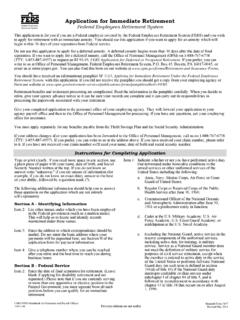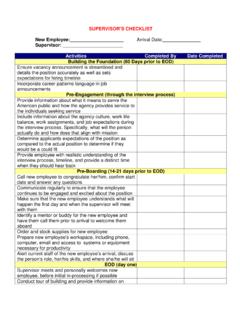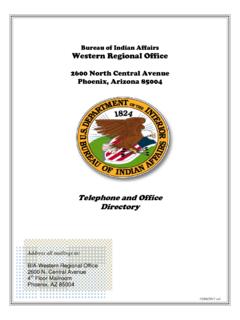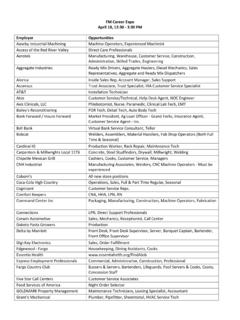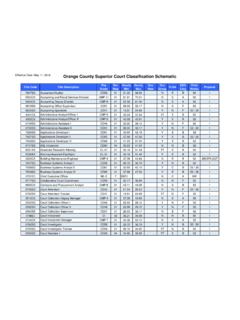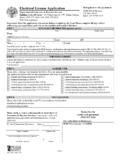Transcription of Federal Wage System Job Grading Standard for ...
1 Telecommunications Mechanic, 2502 TS-70 September 1993 Job Grading Standard for Telecommunications Mechanic, 2502 Table of Contents WORK WORK NOT GRADE HELPER AND INTERMEDIATE NOTES TO TELECOMMUNICATIONS WORKER, GRADE TELECOMMUNICATIONS MECHANIC, GRADE TELECOMMUNICATIONS MECHANIC, GRADE US Office of Personnel Management 1 Telecommunications Mechanic, 2502 TS-70 September 1993 WORK COVERED This Standard is for Grading nonsupervisory jobs involved in installing, modifying, troubleshooting, repairing, and maintaining voice and nonvoice communication systems including central office, private branch automatic exchanges (PBAXs), local area network systems, telephone sets, wire carrier equipment, communication cable, alarm systems, intercom and public address systems, and teletype equipment. The work requires knowledge of telephone and data circuitry equipment and installation procedures; knowledge of basic electrical and electronic principles as they pertain to voice and nonvoice transmissions; the ability to understand and follow such technical guidance as circuit descriptions, schematics, and layout sheets; and the ability to locate and repair trouble within the telecommunications System .
2 This Standard cancels and supersedes the Job Grading Standard for Telephone Mechanic, 2502, issued in May 1973. WORK NOT COVERED This Standard does not cover work that primarily involves: - Work involved in repairing, troubleshooting, calibrating, and testing electronic digital computers and peripheral equipment. (See Electronic Digital Computer Mechanic Series, 2608.) - Work involved in installing, repairing, and troubleshooting communications or other equipment requiring an in depth knowledge of electronics principles. (See Job/ Grading Standard for Electronics Mechanic Series, 2604.) - Work pertaining to the planning, development, acquisition, and utilization of telecommunications systems, facilities, services, and procedures. (See Position Classification Standard for Telecommunications Series, GS-0391.) - Work pertaining to the design, development, evaluation, and testing of electronic systems and equipment. (See Position Classification Standard for Electronics Technician Series, GS-0856.)
3 TITLES Jobs graded by this Standard below grade 10 (other than helper and intermediate jobs) are titled Telecommunications Worker. Jobs graded by this Standard at grade 10 and above are titled Telecommunications Mechanic. US Office of Personnel Management 2 Telecommunications Mechanic, 2502 TS-70 September 1993 GRADE LEVELS This Standard does not describe all possible grades at which jobs might be classified. If jobs differ substantially from skill, knowledge, or other work requirements described in the Standard , they may be graded either above or below the grade levels described based on sound job Grading methods. HELPER AND INTERMEDIATE JOBS Helper jobs are graded by the Office of Personnel Management Job Grading Standard for Trades Helper Jobs. The grade 8 level described in this Standard DOES NOT apply to jobs that are part of a planned program of training and development of skills for advancement to a higher grade. Such trainee jobs are covered by the Office of Personnel Management s Job Grading Standard for Intermediate Jobs.
4 Grade 10 in this Standard is to be used as the "full performance" level or grade in applying the Intermediate Job Grading Table. NOTES TO USERS Ongoing technological advancements in the field of electronics have had and will continue to have an impact upon electrical systems, components, and equipment found in telecommunications systems. As a consequence, work within this occupation, in certain work situations, may require knowledge of electronic principles ranging from a practical understanding to a working knowledge. However, in determining appropriate grade levels for work within this occupation, it is essential to note that the knowledge of electronics required of telecommunications workers and telecommunications mechanics is significantly less than that required of electronics workers and mechanics at comparable grade levels. For this reason, please disregard the discussion on Page 14 of the INTRODUCTION TO ELECTRONIC EQUIPMENT INSTALLATION AND MAINTENANCE FAMILY, 2600, about work in digital switching centers requiring a depth of electronic knowledge which places the work in the 2600 family.
5 (Note: The introduction to the 2600 family will be revised to delete the above reference.) Pay Categories: In a least one instance there is a superficial similarity between work described in the Telecommunications Series, GS-0391, and the Telecommunications Mechanic, 2502. However, the determination of proper pay category is based on the predominant knowledge and skill requirements, not on isolated instances of installation and modification work mentioned in one or two general schedule series. For example, installation and modification of telecommunication facilities is mentioned briefly in the telecommunication Standard , GS-0391. But installation and modification work in this series is an oversight function and is secondary to the major roles of designing, developing, planning, and acquiring telecommunications systems, facilities, and services. Also, while the telecommunications US Office of Personnel Management 3 Telecommunications Mechanic, 2502 TS-70 September 1993 mechanic must have a working knowledge of electronics principles and computer data bases, the paramount requirement is a comprehensive knowledge of voice and nonvoice transmission principles to install and repair communications systems.
6 TELECOMMUNICATIONS WORKER, GRADE 8 General: Grade 8 telecommunications workers perform work involved in the routine installation, removal, maintenance, troubleshooting, and repair of voice and/or nonvoice communications systems. Working from job layouts, work sequences, and material requirements established by higher level workers, they install and terminate copper core and/or fiber optic house cables. They run cables, key cables, or house wire to all telephone sets, terminal connectors, lugs, pins, or screws, associated with key telephone equipment and/or terminating equipment for nonvoice circuits. They install and repair communication equipment such as call stackers, multiple-button sets, extension ringers, coaxial cables, various type connectors, and AB switches. They use Standard handtools and a variety of test equipment such as voltmeters, ohmmeters, current flow and continuity testers, and handsets to locate and diagnose analog and digital telephone set failures. They inspect, repair, modify, and maintain a variety of telecommunication equipment such as single, dual-line, multiple-button electromechanical, and digital telephones.
7 They assist higher grade workers in installing, removing, maintaining, troubleshooting, and repairing electronic and electromechanical telephone key systems/PBAXs; intercom and public address systems; alarm systems; and teletype equipment. They may operate a crew truck to and from work sites. Skill and Knowledge: Grade 8 telecommunications workers require a practical knowledge of the characteristics, relationships, and measurement techniques of AC and DC current and a general understanding of basic electronic principles to perform work involved in the routine repair, disassembly, modification, assembly, testing, installation, and maintenance of telecommunications systems, equipment, and accessories. They know how to locate and diagnose the nature of trouble by tracing and measuring electrical current and digital signals through circuits for continuity and proper operation. They apply knowledge of wire color codes, layout sheets, wiring diagrams, and schematics to complete assignments.
8 Telecommunications workers at this level are skilled at inspecting and repairing electromechanical, solid state, and digital telephone equipment. They have skill in the use of common electrical test devices such as ohmmeters, voltmeters, current flow and continuity testers, and handsets to perform basic checks for continuity, resistance, voltage, opens, shorts, insulation breakdowns, and grounds. They have skill in the use of handtools such as electrical and manual hand drills, screwdrivers, long-nosed pliers, hammers, diagonal cutters, and other specialized tools of the trade. Responsibility: Grade 8 telecommunications workers receive work assignments from their supervisor or higher grade worker. Work assignments are typically supplemented with wiring diagrams, layout sheets, and schematics concerning systems, equipment, and cable to be installed, modified, tested, and/or removed. On routine assignments, grade 8 telecommunications workers independently select tools and test equipment.
9 They plan the work US Office of Personnel Management 4 Telecommunications Mechanic, 2502 TS-70 September 1993 sequence and decide which methods and techniques to follow in completing work assignments. Decisions and judgments are clearly controlled by established operating procedures and detailed instructions. Routine work assignments are typically carried out with little or no review in progress. They receive detailed instructions from their supervisor on new or unusual work assignments. All work is subject to review in progress and upon completion for efficiency in operation of the System or equipment repaired and/or installed. Physical Effort: The work requires frequent bending, pulling cables, working in awkward positions, walking and standing for long periods of time, and climbing ladders. In addition, the work requires lifting and carrying items weighing up to 9 kilograms (20 pounds) unassisted and occasionally up to 23 kilograms (50 pounds) with assistance of lifting devices or other workers.
10 Working Conditions: Work is performed inside and outside in all types of weather. Inside work areas can range from well lighted, heated, and climatically controlled to poorly illuminated work areas such as attics, crawl spaces, and basements. Workers are exposed to dust, dirt, and falls from ladders while installing cable. Workers are exposed to bruises and minor cuts from handling cable and equipment and from using handtools. TELECOMMUNICATIONS MECHANIC, GRADE 10 General: Grade 10 telecommunications mechanics install, remove, maintain, modify, troubleshoot, and repair voice and/or nonvoice communications systems including intercom and public address systems; alarm systems; teletype equipment; and electronic and electro-mechanical telephone key systems/PBAXs; terminal and communications equipment, including modems, multiplexers, fiber-optic end equipment, T1-carriers, and line drivers. In comparison to grade 8 workers who have job requirements established by higher level workers, grade 10 telecommunication mechanics independently survey the installation area to determine work methods, tools, and materials required to accomplish the project.





